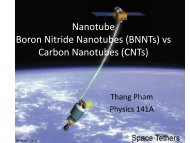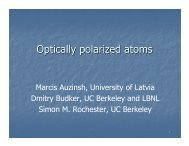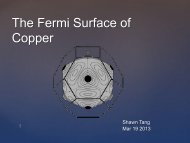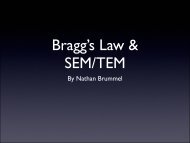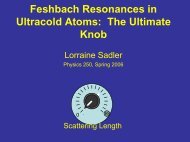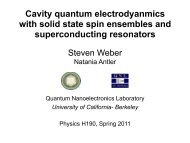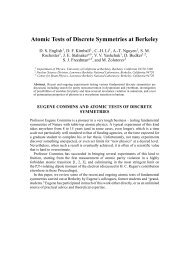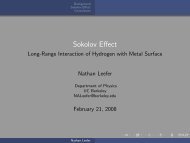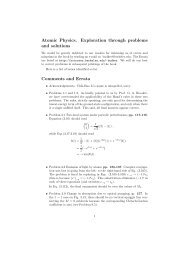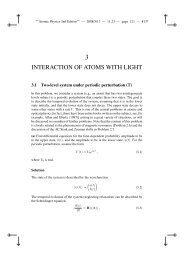Resonant nonlinear magneto-optical effects in atomsâ - The Budker ...
Resonant nonlinear magneto-optical effects in atomsâ - The Budker ...
Resonant nonlinear magneto-optical effects in atomsâ - The Budker ...
You also want an ePaper? Increase the reach of your titles
YUMPU automatically turns print PDFs into web optimized ePapers that Google loves.
19<br />
Index of refraction Number of atoms<br />
Pump<br />
B⩵0<br />
Probe<br />
B≠0<br />
0<br />
Atomic velocity<br />
Ren 1, Ren 1<br />
0<br />
Probe laser detun<strong>in</strong>g<br />
a<br />
12, 12<br />
b<br />
φ ∝ Ren Ren <br />
FIG. 11 <strong>The</strong> Bennett-structure effect on a 1/2 → 1/2 transition<br />
<strong>in</strong> which the upper state decays to levels other than<br />
the lower state; B pump = 0, B probe ≠ 0. (a) In the pump<br />
region, monochromatic laser light produces Bennett holes <strong>in</strong><br />
the velocity distributions of atoms <strong>in</strong> the lower state |+1/2〉,<br />
|−1/2〉 sublevels. S<strong>in</strong>ce there is no magnetic field, the holes<br />
occur <strong>in</strong> the same velocity group (<strong>in</strong>dicated by the dashed<br />
l<strong>in</strong>e) for each sublevel. (b) In the probe region, a magnetic<br />
field is applied, shift<strong>in</strong>g n + and n − relative to each other<br />
(upper trace). <strong>The</strong> real part of the <strong>in</strong>dices of refraction are<br />
shown; so that the features <strong>in</strong> plot (a) correspond to dispersive<br />
shapes <strong>in</strong> this plot. <strong>The</strong> shifted central detun<strong>in</strong>gs of the<br />
BSR features are <strong>in</strong>dicated by the dashed l<strong>in</strong>es. Polarization<br />
rotation of the probe laser light is proportional to the difference<br />
Re n + − n −(lower trace). Features due to the Doppler<br />
distribution and the Bennett holes can be seen. S<strong>in</strong>ce the Bennett<br />
related feature is caused by the removal of atoms from<br />
the Doppler distribution, the sign of rotation due to this effect<br />
is opposite to that of the l<strong>in</strong>ear rotation.<br />
whether a magnetic field is present <strong>in</strong> the pump region,<br />
and whether the excited state decays to the ground state<br />
or other levels, BSR NMOR can be due to holes, (and<br />
have one sign), be due to “peaks” generated by spontaneous<br />
decay to the ground state (and have the opposite<br />
sign), or not be present at all.<br />
Note also that mechanical action of light on atoms<br />
could, under certa<strong>in</strong> conditions, lead to redistribution of<br />
atoms among velocity groups, thus deform<strong>in</strong>g the Bennett<br />
structures and modify<strong>in</strong>g the <strong>nonl<strong>in</strong>ear</strong> <strong>optical</strong> properties<br />
of the medium (Kazantsev et al., 1986).<br />
B. Coherence <strong>effects</strong><br />
<strong>The</strong> coherence <strong>effects</strong> can produce even narrower<br />
widths than the Bennett-structure-related NMOE, thus<br />
lead<strong>in</strong>g to significantly higher small-field Faraday rotation<br />
(Arimondo, 1996; Gawlik, 1994). At low light power,<br />
the effect of the pump light can be conceptually separated<br />
from that of the magnetic field, so that the coherence effect<br />
can be thought of as occurr<strong>in</strong>g <strong>in</strong> three stages. First,<br />
atoms are <strong>optical</strong>ly pumped <strong>in</strong>to an aligned state, caus<strong>in</strong>g<br />
the atomic vapor to acquire l<strong>in</strong>ear dichroism; second, the<br />
atomic alignment precesses <strong>in</strong> the magnetic field, rotat<strong>in</strong>g<br />
the axis of dichroism; third, the light polarization is<br />
rotated by <strong>in</strong>teraction with the dichroic atomic medium,<br />
s<strong>in</strong>ce the alignment is no longer along the <strong>in</strong>itial light<br />
polarization. <strong>The</strong> third, “prob<strong>in</strong>g,” step does not require<br />
high light <strong>in</strong>tensity, and can be performed either with a<br />
weak probe beam or with the same pump light as used<br />
<strong>in</strong> the first step.<br />
Consider atoms with total angular momentum F = 1<br />
that are not aligned <strong>in</strong>itially subject to l<strong>in</strong>early polarized<br />
laser light with frequency correspond<strong>in</strong>g to a transition<br />
to a F ′ = 0 state. One can view the atoms as be<strong>in</strong>g <strong>in</strong><br />
an <strong>in</strong>coherent mixture of the follow<strong>in</strong>g states: |M = 0〉,<br />
(|M = 1〉 ± |M = −1〉)/ √ 2. <strong>The</strong> first of these states can<br />
be excited to the F ′ = 0 state only by z-polarized radiation;<br />
it is decoupled from x- and y-polarized light. Similarly,<br />
the other two states (which are coherent superpositions<br />
of the Zeeman sublevels) are y- and x-absorb<strong>in</strong>g<br />
states, respectively. Suppose the laser light is polarized<br />
along the x-axis. Optical pump<strong>in</strong>g by this light causes<br />
depletion of the x-absorb<strong>in</strong>g state, leav<strong>in</strong>g atoms <strong>in</strong> the<br />
“dark” y- and z-absorb<strong>in</strong>g states. 21 <strong>The</strong> medium becomes<br />
transparent for the x-polarized radiation; however,<br />
it can still absorb and refract light of an orthogonal polarization.<br />
<strong>The</strong> medium is aligned 22 (Appendix B.1) and<br />
possesses l<strong>in</strong>ear dichroism and birefr<strong>in</strong>gence. 23<br />
In the presence of a magnetic field, the atomic alignment<br />
axis precesses around the direction of the field at<br />
the Larmor frequency [precession of atomic alignment <strong>in</strong><br />
a magnetic field is expla<strong>in</strong>ed <strong>in</strong> detail <strong>in</strong>, for example,<br />
Corney (1988, Ch. 15)]. One can understand the effect<br />
of this precession on the light polarization by th<strong>in</strong>k<strong>in</strong>g of<br />
the atomic medium as a layer of polariz<strong>in</strong>g material like<br />
a polaroid film (<strong>Budker</strong> et al., 1999b; Kanorsky et al.,<br />
1993). It is easy to show that the rotation of the “polarizer”<br />
around the z-axis causes the l<strong>in</strong>ear output po-<br />
21 This process is known as coherent population trapp<strong>in</strong>g (Arimondo,<br />
1996) because, as a result of <strong>optical</strong> pump<strong>in</strong>g by l<strong>in</strong>early<br />
polarized light, atoms <strong>in</strong> the |M = ±1〉 substates are not completely<br />
pumped out as would seem to be the case at first glance<br />
(see Fig. II.A), but largely rema<strong>in</strong> <strong>in</strong> a dark coherent superposition.<br />
22 In general, alignment can exist for an F ≥ 1 state even when<br />
there is no dark state [i.e., for F → F + 1 transitions (Kazantsev<br />
et al., 1984)].<br />
23 <strong>The</strong> l<strong>in</strong>ear birefr<strong>in</strong>gence turns out not to be important for the coherence<br />
effect because the refractive <strong>in</strong>dex is unity on resonance.<br />
Note however, that at high light powers, circular birefr<strong>in</strong>gence<br />
emerges as a dom<strong>in</strong>ant effect responsible for <strong>nonl<strong>in</strong>ear</strong> Faraday<br />
rotation (see Sec. V.C).





